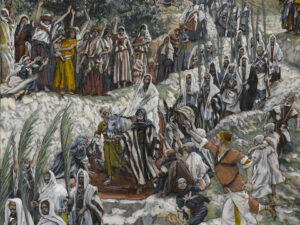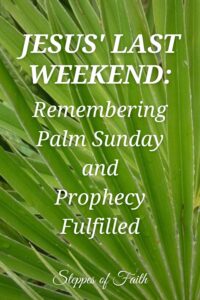
“Blessed is He who comes in the name of the Lord! Hosanna in the highest!” (Matthew 21:9)
Palm Sunday is an often-overlooked holiday lost in the rush to get to Easter, even in churches. But the day is very significant and worthy of study. Palm Sunday is the day that not only began Jesus’ final walk to the cross but also fulfilled a few prophecies.
According to the gospel accounts, Jesus and His disciples had been making their way to Jerusalem for several weeks to celebrate Passover. Along the way, Jesus healed a blind man, cleansed ten lepers, met Zacchaeus, and told a lot of parables. They finally reached the area of Bethphage and Bethany, located a few miles outside of Jerusalem, on Sunday, 9 Nisan, 30 AD. Later that day, Jesus made His triumphal entry into Jerusalem.
The date is significant. It was precisely 483 years (a biblical seventy weeks) after Artaxerxes’ decree given by the angel Gabriel found in Daniel 9.
“Seventy weeks are determined for your people and for your holy city to finish the transgression, to make an end of sins, to make reconciliation for iniquity, to bring in everlasting righteousness, to seal up vision and prophecy, and to anoint the Most Holy.”
Jesus’ arrival in Jerusalem was the day He began fulfilling the first of many Old Testament prophecies, including Artaxerxes’ prophetic decree. He finished the transgression (restrained sin) and ended and reconciled it (put it away through His sacrifice on the cross). Five days later, on what is known as Good Friday, He established His Messianic kingdom.
The Daniel 9 prophecy also says Jesus will bring in everlasting righteousness and seal up vision and prophecy, and the Father will anoint Him as “the Most Holy.” These parts of the prophecy and others pertaining to the Antichrist will be fulfilled at Jesus’ future second coming.
The White Donkey
Jesus fulfilled a second prophecy that first Palm Sunday—He rode into the city on a donkey.
As Jesus prepared to enter Jerusalem on 9 Nisan, Luke 19 says He sent two disciples into a nearby village to fetch a young donkey “on which no one has ever sat (v30).” Jewish culture considered such an animal to be worthy of holy purposes. In this case, it matched with Jesus’ deity.
Matthew 21:2 says the disciples also found a mare, presumably the donkey’s mother. Scholars suggest Jesus also asked for the mare to help calm the young donkey. After the disciples brought the donkey, they laid their clothes across its back and placed Jesus on it (v7). They then began walking into the city, thus fulfilling a prophecy found in the book of Zechariah.
“Tell the daughter of Zion, ‘Behold, your King is coming to you lowly and sitting on a donkey, a colt, the foal of a donkey.’” (Zechariah 9:9)
The use of a donkey is highly significant. Donkeys are humble animals, not majestic and proud like horses. At the time, members of royalty and the military used horses, and this is what the Jewish people expected to see when the Messiah finally arrived. They expected to see Him on a grand horse, ready to defeat the Roman occupation and free them from oppression.
But Jesus, as a humble servant of the Father, chose an animal that matched his attitude and spirit. The people would have instantly noted His choice of animal. It spoke volumes.

Why It’s Called Palm Sunday
The gospel writers record Jesus’ ride into Jerusalem through the Beautiful Gate as the Triumphal Entry. Despite the confusion about the donkey, the people spread their clothes and palm branches on the road as He passed, and sang,
“Hosanna to the Son of David! Blessed is He who comes in the name of the LORD! Hosanna in the highest!” (Matthew 21:15)
Waving palm branches was an ancient, common form of celebrating stemming from God’s command in Leviticus 23:40 regarding the Feast of Tabernacles. Placing clothes on the ground was reserved only for high royalty. Mark 11:9-10 records this moment slightly differently.
“Hosanna! Blessed is He who comes in the name of the Lord! Blessed is the kingdom of our father, David, that comes in the name of the Lord. Hosanna in the highest!”
In both verses, the people directly quote Psalm 118:26, which they often sang at Jewish religious festivals, especially at Passover. Mark’s version of the event indicates that the crowd—made up of both Jews and Greeks—acknowledged Jesus as the one bringing in the kingdom promised to David’s Son.
Such a joyous, festive atmosphere would indicate that the people recognized Jesus as a king. As far as they were concerned, God had finally answered their prayers.
Hail King Jesus
God had, indeed, come to deliver the Israelites, but not from what the Jews thought.
In keeping with rabbinical teaching, the Jews expected a king or a high-ranking general to come to their defense by overthrowing the Roman Empire and re-establishing the autonomy of their nation. Indeed, they got a king, but not the kind they had in mind. Instead of the Romans, Jesus, the King of Kings, came to triumph over a greater enemy—sin and death.
On 9 Nisan, 30 AD, just as foretold, Jesus came into Jerusalem to finish His walk to the Roman execution stake and establish His kingdom. His obedience should move us to celebrate Palm Sunday with a fresh perspective. His arrival was not simply a grand entrance. It was so much more.
Because of Palm Sunday, Jesus can rightly claim He is who He says He is. The Bible contains countless prophecies about the events of Jesus’ final week, and we can see how He fulfilled them all in the gospels.
Jesus is the promised Messiah, the holy Son of God, who came to make the sacrifice we could not. He paid our debt in full and made a way through His grace for us to have victory and freedom over sin. One day, He will return to complete the Daniel 9 prophecy and eternally establish His kingdom on earth. That alone should move us to joyfully cry out as the people did that first Palm Sunday.
“Blessed is He who comes in the name of the Lord!”

Beyond Palm Sunday
Jesus did much more in those days between Palm Sunday and Good Friday.
- The giving of the Greatest Commandment (Matthew 22:37-39, Mark 12:30-31): “And you shall love the Lord your God with all your heart, with all your soul, with all your mind, and with all your strength. This is the first commandment. And the second like it, is this: ‘You shall love your neighbor as yourself.’ There is no other commandment greater than these.”
- The cleansing of the temple (Matthew 21:12-13, Mark 21:12, Luke 19-45-46))
- The washing of feet (John 13:2-17)
- A warning to watch for the signs of the last days and Jesus’ second coming (Mark 13:5-37, Mark 24:4-26, Luke 21:8-24)
- The institution of the Lord’s Supper (Matthew 26:26, Mark 14:22-25, Luke 22:19-20)
- The betrayal by Judas Iscariot that helped to secure Jesus’ arrest (Psalm 41:9, Matthew 26:47-49, Mark 14:43-52, Luke 22:47-53, John 18:1-11)
The Romans helped fulfill additional prophecies on the day of Jesus’ crucifixion, the primary ones occurring when He hung on the cross.
- The Roman soldiers gave Jesus sour wine to drink to prolong His suffering (Psalm 69:21)
- None of Jesus’ bones were broken (John 19:36, Exodus 12:46, and Numbers 9:12)
- The Romans pierced Him with a spear (Zechariah 12:10)
- His garments were not torn apart (Psalm 22:18)
The prophet Isaiah also foretold Jesus’ atoning sacrifice in great detail in Isaiah 53.
This Palm Sunday, take a moment to remember the significance of Jesus’ final days on earth and how it began when He triumphantly entered Jerusalem. Even if your pastor or minister fails to mention anything about it, make a purposeful effort to give the Lord praise and appreciation.
He was thinking of you that day.
And He still is.
Additional Readings About Palm Sunday and Easter:
The History and Prophecy of the Triumphal Gate Entry
Did Jesus Really Die on Good Friday?
The Science of Crucifixion, Part One
The Science of Crucifixion, Part Two
